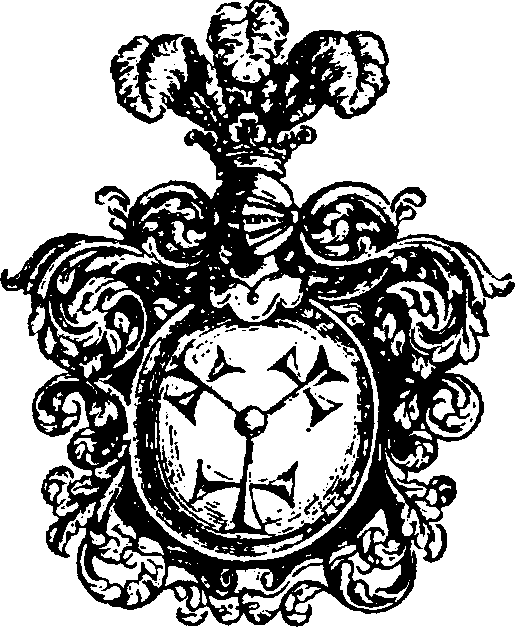Herb Brodzic
Research Heraldry Herb Brodzic
Herbarz Polski translation
Brodzic herb
 The following is a direct translation from the classical genealogical and heraldic reference "Herbarz Polski" by Kasper Niesiecki, S. J., Lipsk edition, 1839-1846.
The following is a direct translation from the classical genealogical and heraldic reference "Herbarz Polski" by Kasper Niesiecki, S. J., Lipsk edition, 1839-1846.
On a red field are three golden crosses, placed so that one of them is pointed straight down while the two above are placed to the side of a triangle, and the ends of all three meet in the center. There is, however, this difference, that some use these arms with a circle, placed in the center where the crosses meet, and on a blue field, while others do not have this circle. On the helm are three ostrich feathers, but some use five. I would take this circle to be a ring, inasmuch as our Ks. Petrasancta, cap. 63 always takes such circles to be rings ex usu Fecialium and says that in Swabia, Austria, and near the Rhine there are many such families who bear rings in their coats of arms; evidently (here I am stating his opinion) the rings were acquired in those days when men would strive in a glorious competition for a ring which was bestowed upon him who won. Despite all this that author has none among the various coats of arms like those of Brodzic, only in fol. 48 he has one with one such cross, elongated and extended in the extremities, of gold, on a circle of vigorous color: he adds that this was the arms of Cadwallader, the latest King of Britain. The same author writes in that same work on the merits of this cross, and I refer those interested to him. Also writing about this were Paprocki in Gniazdo, fol. 89., 0 herbach, fol. 269, and Okolski, vol. 1, fol. 79, and Liber Klejnoty, fol. 42, and MS. P. Rutka.
Paprocki ascribes the origin of these arms to this occasion, to which they all bear witness. Kazimierz the Monk, King of Poland, was waging war against the tyrant Mieclaw and the Jadzwings associated with him, when one plucky young Pole displayed his courage to him on all occasions, protecting his side, for which he was given numerous properties in Mazovia and granted this coat of arms. Rev. Rutka designates 1038 as the year of this origin, and says that the man had a long and handsome beard, and he and the arms were named Brodzic [from broda = "beard" in Polish]. But others derive the origin of this name from the name of his estates at Brody. Paprocki recalls that he saw on the list of founders of a Płock church in 1106 three brothers, born counts of Brody, Wzebor, Swentoslaw, and Krystyn, who bequeathed a tithe from their estates to that church. There is furthermore a small town in the Płock district called Plodsko, at one time a village near which the Brodzices had numerous estates. Of Stefan, Multanski voivode, they write that after he had defeated a hundred thousand Turks, in commemoration of this victory he erected three crosses of stone. Długosz speaks of this family, calling it "Genus Polonicum providum et in Masovia propagatum" [a provident Polish clan, widespread in Mazovia].
[Krasicki's notes: 1422. Sieciech z Brodzic, Lublin starosta, signed the alliance between King Wladyslaw of Poland and the Teutonic Knights, Cod. Dip. Vol. IV, fol. 114.]
Bearers of these Arms
| Bonikowski | Pilitowski |
| Kliczewski | Radomski |
| Kunecki | Radziminski |
| Kurzatkowski | Sieromski |
| Lacki | Zawadzki |
| Mojecki | Zochowski |
Copyright © 1992 William F. Hoffman. Used by permission. This article originally appeared in Polish Genealogical Society Newsletter (Vol. XV, No. 1, Spring 1992), the bulletin of the Polish Genealogical Society.
;
